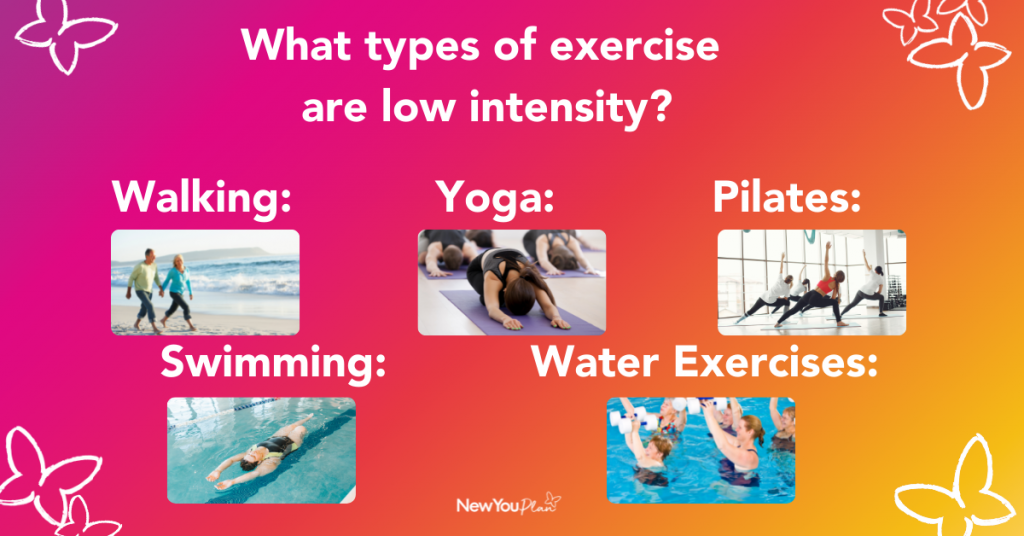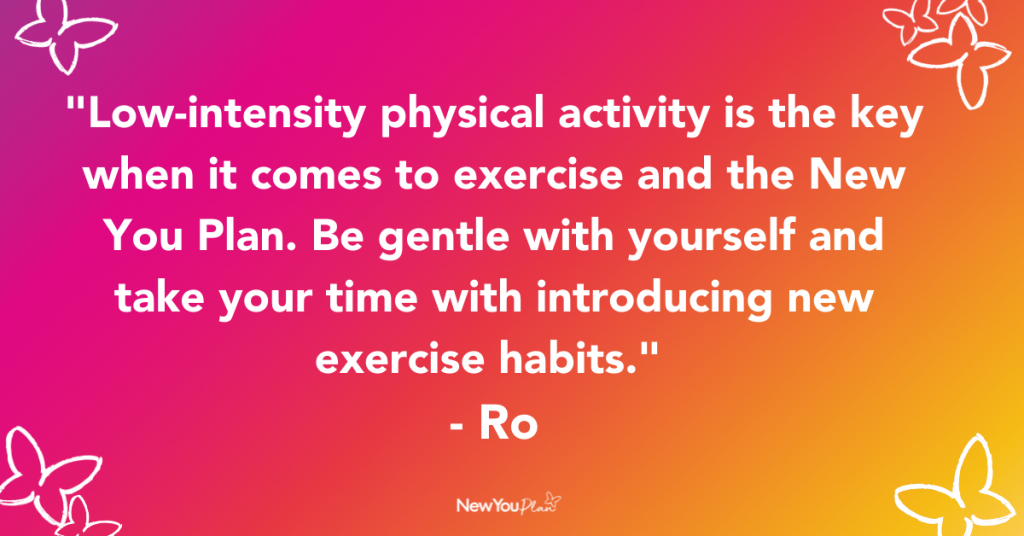There is no doubt that exercise should be a part of your life as it brings about a whole lot of benefits to both your body and your mind. But when you start with the New You Plan we suggest that you hold back when it comes to getting a sweat on. Low-Intensity Physical Activity is the key and our delightful dietician Ro explains why.
On The New You Plan, your body will typically be receiving approximately 800 calories per day and by doing this you will start to lose weight quite rapidly.
This may be quite a change to the norm for you and so it is not recommended to undertake any new strenuous high intensity exercise regimes at this time as your body will be in an energy deficit already and we do not want to add additional strains. There are however some activities you can do, to start moving your body more, that are gentle, but yet still effective.
Creating a new habit
Starting to incorporate some light activity or movement into your routine every day can support the weight loss results you will start to see. Starting off slowly and at a low intensity for a short period of time, around 20 minutes per day, is the best plan of action.
Taking the time to embed this movement into your routine can help you to form a habit of moving your body every day, helping you build up to becoming more active when you and your body are ready.
Low-intensity physical activity
Exercising or being active doesn’t have to be intense such as running or hitting the gym, low-intensity steady-state exercise has been shown to aid with the reduction in body weight without having to engage in intense exercise (1). It is also particularly appropriate for beginners as it doesn’t necessarily require equipment or starting something new.
What types of exercises are low intensity?
There are lots of ways that you can start to incorporate activity and movement into your routine
- Walking is a low impact and low intensity way to move your body – increase your pace and/or distance gradually. Getting more fresh air on a regular basis can also help improve mood and mental wellbeing
- Yoga can improve physical fitness, strength and wellbeing. Building strength can help us to perform everyday tasks better as well as helping to reduce the rate of bone and muscle loss which is associated with aging. Try out different classes and instructors to find what works for you.
- Pilates can be helpful for rebalancing the body through slow controlled movements and exercises which also improve muscle strength – as with yoga there are options to do this at home or in a group class setting at the level that works for you.
- Not all gym equipment has to be high impact and high intensity, using a cross trainer can be a low impact and low intensity activity – start off slow and for short amounts of time and build up as and when you feel ready.
- Swimming is a great way to move and strengthen many muscles in our body that we may not move through our everyday activities as it works your whole body. Breaststroke is the lowest intensity stroke, as well as aiding weight loss, swimming has also been shown to improve sleep and mental wellbeing.
- Water exercises are a great option for people starting out with fitness and looking to move more, water supports your body minimising the impact on your joints making it suitable for anyone.
- We can also incorporate more movement into our lives without formally doing exercise e.g., take the stairs rather than a lift or escalator, walk or cycle to shops/work/school rather than drive, park a little further away, suggest a walking meeting, go for a walk at lunchtime, avoid sitting where possible if not required

Slow and steady wins the race
Using one or a combination of these low-intensity options to increase your activity levels can help you to form a habit of moving your body daily. Starting off slowly and for short periods of time is important when your calorie intake is very low as doing too much may lead to fatigue and reduced energy levels, and in some cases may be unsafe.
Creating a lifestyle or routine where you incorporate some form of daily exercise or movement at this stage can help with long term weight maintenance once you start to include more calories in your diet. When you are ready you will be in a position to increase the duration of your activities as well as feel stronger and more able to do so, helping you to maintain your desired weight.
Low-intensity physical activity is the key when it comes to exercise and the New You Plan. Be gentle with yourself and take your time with introducing new exercise habits.
We may say that slow and steady wins the race, but your transformation is a journey. Take it at your own pace and experiment with what works for you and makes you happy.
If you found this helpful, when you’re ready to move onto to Switch, we recommend you seek out Ro’s other blogs for help and inspiration on how to incorporate healthy food into your diet. There are also lots of meal ideas from customers over on the New You’s Switch Facebook group.

References
1. Ross R, Stotz PJ, Lam M. Effects of exercise amount and intensity on abdominal obesity and glucose tolerance in obese adults: A randomized trial. Ann Intern Med. 2015 Mar 3;162(5):325–34.
The post Low-Intensity Physical Activity When On The New You Plan appeared first on The New You Plan.
Vikki Bilbey
Comments
Post a Comment